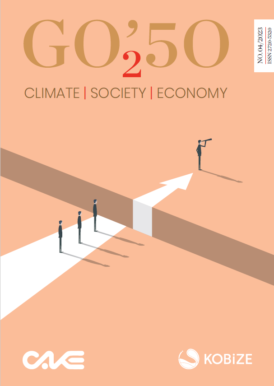“GO2’50. Climate. Society. Economy” vol .4
We would like to invite you to read our fourth issue of the publication entitled ‘GO2’50: Climate. Society. Economy.” (No. 4/2023) prepared by the National Centre for Emissions Management and the Centre for Climate and Energy Analysis. Publication is available in the Polish and English language.
- Publication in English language:
 GO2'50.Climate.Society. Economy_No.4_2023 (4.8 MiB, 98 hits)
GO2'50.Climate.Society. Economy_No.4_2023 (4.8 MiB, 98 hits)
- Publication in Polish language:
 GO2’50. Klimat. Społeczeństwo. Gospodarka. (Nr 04/2023) (5.1 MiB, 146 hits)
GO2’50. Klimat. Społeczeństwo. Gospodarka. (Nr 04/2023) (5.1 MiB, 146 hits)
We are excited to present the fourth issue of the publication ‘GO2’50’, published by the National Centrefor Emissions Management (KOBiZE) operating at the Institute of Environmental Protection – NationalResearch Institute (IOŚ-PIB). The year 2023, intensive in terms of events concerning the continuation of global changes, was a time of adaptation and recovery measures for all of us in the face of climatepolicy, economic and political challenges.
The recent months have been a time when we have beenexperiencing dynamic transformation of the EU energy and climate policy, in particular in the context of the ‘Fit for 55’ package as well as the reform of the EU Emission Trading System (EU ETS). In this issue, a lot of space is devoted to the analysis and interpretation of these significant changes that have a directimpact on the EUA prices in the EU ETS and the future of the entire system.
The first article explores the complexities of the EU ETS market in 2023, providing an overview of relevanttrends and predictions for its development. The ‘Fit for 55’ impact on both the MSR reserve and the EUAprices and number of allowances in the EU ETS is discussed in particular, what in our opinion can help broaden the perception and understanding of new challenges and opportunities we all face within theCommunity climate policy.
Momentous changes and developments of the EU climate policy measuresare discussed in the next article, focused on the new emissions trading system for buildings and theroad transport, named ETS2, which extends the scope of carbon pricing. Authors focus on the legal conditions and consequences of this system and its impact on households in the EU, which seems crucial to illustrating and understanding the broad implications of these new regulations.
In this issue we also discuss new policy measures, such as the carbon border adjustment mechanism CBAM) and the roleof ‘green hydrogen’ in the mix of efforts towards the energy sector decarbonisation.
Furthermore, as a continuation of our educational and information mission, we present an article discussing the proposal for the European CO2 removal certification system and the AgETS system for agriculture, which are increasingly present in discussion on the path towards the EU climate neutrality in 2050. The question of carbon removals is explored also in the last article, in particular focused on the role of tropical forests, voluntary carbon markets and the REDD+ instrument.
As we all begin the debate on setting the EU climate policy targets for 2040 and accordingly the architecture of climate policy, we believe that articles we share will be received not only as a source ofknowledge, but also as an inspiration to contribute to this discussion and exploration of effective ways to tackle global warming and achieving the climate neutral Europe in 2050.
We warmly encourage you to read the issue, share your comments and join the EU debate.
Back

 Reset ustawień
Reset ustawień Kontrast
Kontrast Widok
Widok Czytelność
Czytelność Czcionka
Czcionka Znaki
Znaki Interlinia
Interlinia Słowa
Słowa Akapity
Akapity Deklaracja dostępności
Deklaracja dostępności









